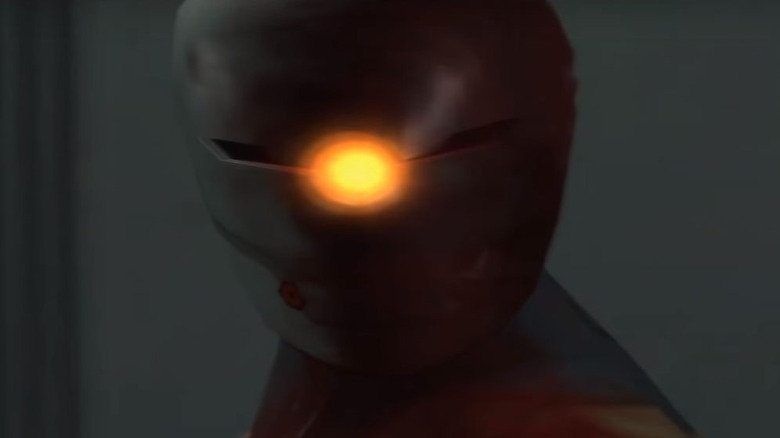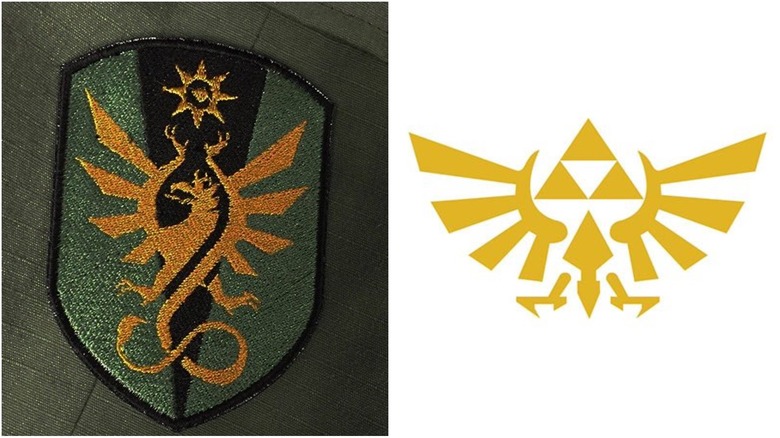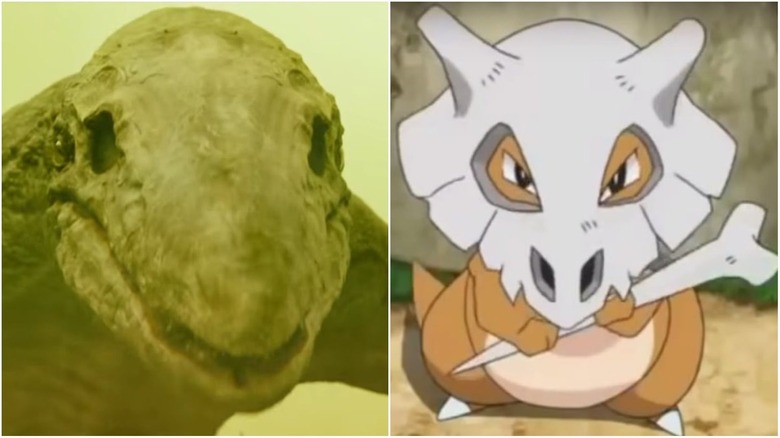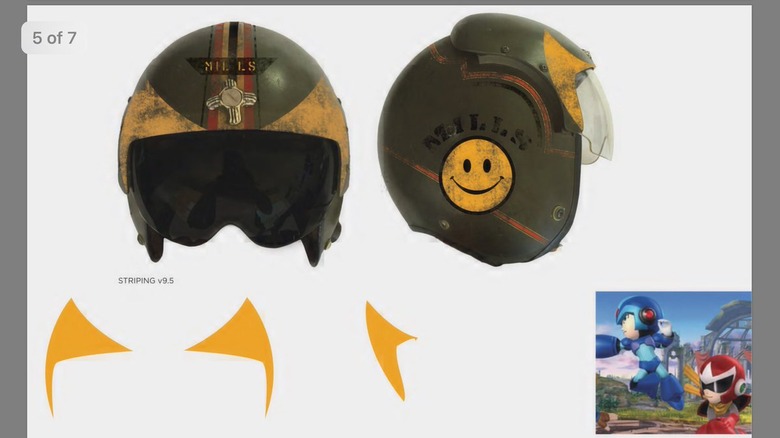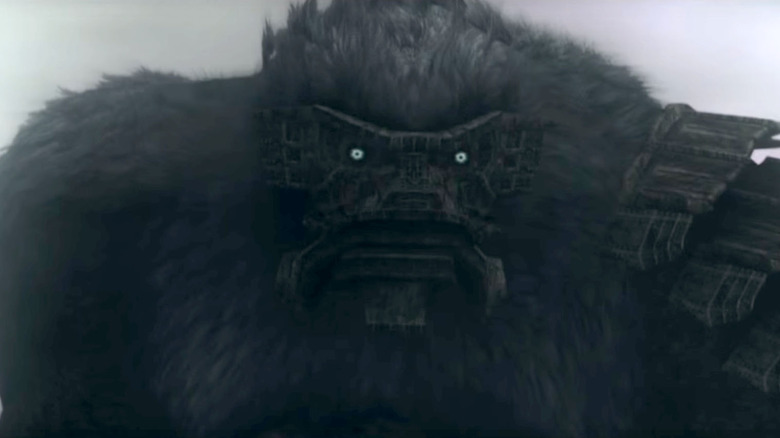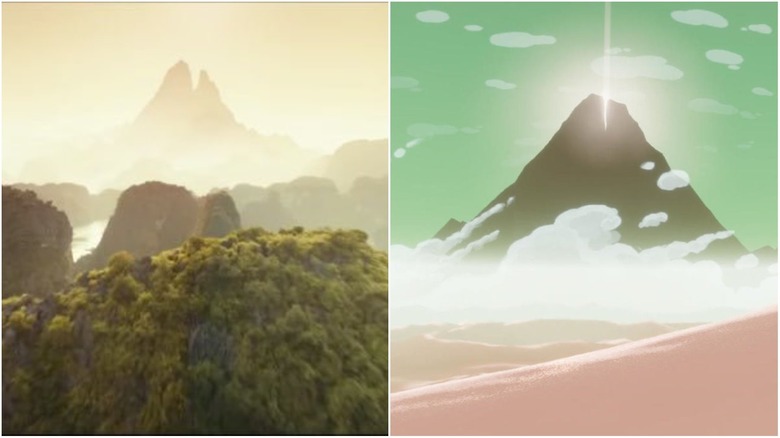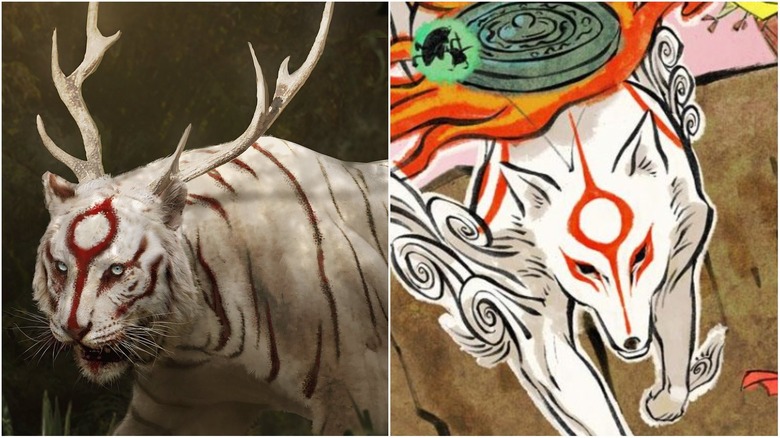Video Game Easter Eggs You Missed In Kong: Skull Island
In 1981, Shigeru Miyamoto needed a name for his newest character, a giant gorilla. It only made sense that he'd turn to King Kong for help. Like King Kong, Nintendo's number one ape made his name by snatching up pretty ladies and climbing to the top of the tallest structures he could find. Like his namesake, Donkey Kong serves as both a hero and a villain, depending on the circumstances. He's not really a bad guy. He's just misunderstood.
More than three decades after Donkey Kong arrived in arcades, director Jordan Vogt-Roberts returned the favor. In addition to tributes to Jurassic Park, Apocalypse Now and Heart of Darkness, classic kaiju flicks, and various anime series, he stuffed Kong: Skull Island full of video game Easter eggs. Fans found some; Vogt-Roberts revealed others. Many are still out there waiting to be discovered, so what are you waiting for? Boot up your Blu-ray player and start hunting!
Metal Gear Solid
Jordan Vogt-Roberts is a massive Metal Gear Solid fan. "That's one of the most important franchises to me on the planet," he says. "Not even just as a video game, but as a piece of media." In fact, Vogt-Roberts' passion for the franchise explains why Sony recruited him to helm Metal Gear Solid's big-screen adaptation back in 2014.
But why wait? While development on Metal Gear Solid continues—allegedly, Vogt-Roberts is still working to get the script just right—the director couldn't help but put a little bit of Metal Gear into Skull Island. The ramshackle boat that John C. Reilly's character lends to Skull Island's stranded adventurers is named "Gray Fox." If that sounds familiar to you, you've probably played a lot of video games.
See, Gray Fox is also a recurring character who's been a part of the Metal Gear franchise since the very beginning. In Metal Gear on the Nintendo Entertainment System, Gray Fox goes missing, and hero Solid Snake must rescue him. In Metal Gear Solid, Gray Fox resurfaces as the Cyborg Ninja, and provides Snake with crucial intel under the name Deepthroat.
According to Vogt-Roberts, Gray Fox was only supposed to be the tip of the iceberg when it came to Skull Island's Metal Gear Solid references. Screenwriter Dan Gilroy wrote a sequence in which Tom Hiddleston's character breaks into a military base, and Vogt-Roberts claims he was going to "get very Metal Gear with it" before the scene was cut. Thankfully, the storyboards for the scene still exist, giving a brief glimpse as to what Vogt-Roberts has in store if and when Metal Gear Solid emerges from development hell.
The Legend of Zelda
In Kong: Skull Island, John Goodman's Bill Randa spearheads an expedition to the titular island, and he doesn't travel alone: in addition to Tom Hiddleston's former British Air Service Captain James Conrad and Brie Larson's photojournalist Mason Weaver, a group of helicopter pilots known as the Sky Devils (led by Samuel L. Jackson's character, Preston Packard) try to keep Randa and his men safe—until Kong attacks, anyway, and scatters the squadron all over the island.
Some of the pilots survive, however, and throughout the film the Sky Devils get a lot of screentime. That gives viewers plenty of time to study their uniforms—which happens to be where Vogt-Roberts hid one of the film's numerous Easter eggs. The resemblance isn't exact, but the Sky Devils insignia looks a lot like the Hylian Wingcrest, which made its first appearance in The Legend of Zelda: The Ocarina of Time and was seen in almost every subsequent The Legend of Zelda game until The Legend of Zelda: Breath of the Wild. According to Vogt-Roberts, the similarity is 100% intentional. Of course, given that Packard emerges as Skull Island's true villain, we're not sure Vogt-Roberts totally understands the Hyrule's legacy. Hey, Jordan: the Hylians are the good guys.
Pokémon
Kong: Skull Island's scariest creatures aren't giant apes or spiders—they're the two-legged reptiles known to John C. Reilly's long-lost war veteran Hank Marlow as the "Skullcrawlers." With sharp claws, sharper teeth, and heads that look like they're made out of solid bone, the Skullcrawlers are both fearsome and fearless predators that hunt both Kong and humans alike. The lead Skullcrawler, the Skull Devil, isn't a mindless beast, either—throughout Skull Island, he shows signs of sadism. He doesn't kill because he's an animal. He kills because it's fun.
And yet, despite their ferociousness, the Skullcrawlers have a cute and cuddly origin. According to a behind-the-scenes feature at Wired, Vogt-Roberts gave the special effects team a single reference to get them started: Cubone, one of the very first Pokémon. It's the kind of thing that, once you know, is impossible to unsee: both creatures have long heads that look like skulls and give way to lizard-like bodies. Both have deep and empty "eye sockets." Of course, there's one big difference between the two: the Skullcrawlers just look like they're wearing another creature's skull. Cubone actually is—allegedly, the vacant skull belongs to his mother—which is, despite appearances, much, much more terrifying.
Mega Man and Metroid
The Legend of Zelda isn't the only big video game franchise that snuck into Kong: Skull Island by way of military regalia. Some of the helmets donned by the pilots in the movie resemble those worn by the heroes in Mega Man, Metroid, and the classic Gundam franchise.
Of course, Samus Aran and Mega Man sport helmets with blocky extra parts. The flight helmets in Skull Island are a lot more realistic, and you have to study the designs closely to see the similarities. 3D extrusions like the caps around Mega Man's ears have been reduced to 2D paintjobs, and the color schemes are totally different. Still, if you look hard enough, you'll notice that many of the same shapes that give Mega Man and Samus' outfits their iconic silhouettes reappear on the helmets. Besides, Vogt-Roberts himself says that the two games were major influences on the costumes' designs (although he admits that "no one will ever notice" the details on their own). That's enough for us to count it, even if the geeks in us wish that the similarities were just a little more pronounced.
Resident Evil
Kong: Skull Island's second trailer introduced King Kong with a stunning 360-degree shot that zooms through a helicopter cockpit before circling the giant ape himself. It's a great and exciting way to highlight Skull Island's biggest star, and in the context of the movie, it goes a long way towards showing just how big Kong really is.
Well, guess what? Vogt-Roberts totally stole the shot from a video game. He's not shy about it, either. "Yes, video games, that's a very video game shot to me," he explained. "That shot actually was inspired by a cinematic in a Resident Evil game." Vogt-Roberts doesn't identify which Resident Evil he's ripping off—there are a lot of 'em out there—but fans think he's probably talking about Operation Raccoon City, a non-canon third-person shooter featuring characters from Resident Evil 2 and Resident Evil 3
"I think video games rewired my brain," the director added. "There are these very video game-inspired ways of conveying information. And moving the camera. And so the video game influences on this movie are like endless and enormous." And so, if you ever wondered why Skull Island has "900 [point-of-view] shots of guns being fired" (an exaggeration, but a small one), well, now you know.
Shadow of the Colossus
If you're making a movie about giant monsters, it makes sense that you'd look to the most famous video game about giant monsters for inspiration. That's exactly what Vogt-Roberts did.
"Shadow Of The Colossus was a huge influence on me on this movie," he told Den of Geek, explaining that the game's main contribution to Kong: Skull Island comes in the form of Kong himself. "The way those creatures lumber around was such a huge, huge part for me... the colossi in those games have such a slow, melancholy, morose quality to them. And the sense of scale," Vogt-Roberts added. "I think and I hope that Kong has a similar vibe in the film."
In other words, if you go into Kong: Skull Island looking for visuals borrowed from Shadow of the Colossus, you won't find them. If you think of Kong as spiritual descendent of the titular Colossi, however, you'll spot Shadow of the Colossus' influence throughout the film. Like Shadow's Colossi, Kong is a majestic and tragic figure. It's no surprise that they go hand in hand.
Journey
In Journey, you must cross a vast desert, trying to reach a glowing mountain in the distance. Along the way, you'll meet other players who share the same goal, and you'll team up to reach your shared destination. But there's a catch: unlike other multiplayer games, Journey doesn't have voice chat. Characters can only communicate through actions or simple musical notes. If you're going to work together, you'll need to figure out how to do it without words.
The resulting journey is one of the strangest and most profound experiences in video game history, and one that transcends the typical multiplayer adventure. Eurogamer calls Journey "a kind of non-denominational religious experience for players." Wired calls it "an emotional, engaging experience" that "constantly challenges your ideas about what videogames can be." Kong: Skull Island director Jordan Vogt-Roberts' review isn't quite as heady, but gives the game just as much praise: "Journey is one of my favorite things... ever."
As such, Vogt-Roberts snuck Journey's illuminated mountain into Skull Island's landscape. The whole thing is just there. The peaks are a little more jagged in Kong, while the mountain's beam of light shines brighter in the game itself, but the silhouette is unmistakable. That's Journey's mountain lurking in the distance, just waiting for intrepid adventurers—or giant apes—to arrive.
Okami
Sadly, not all of Vogt-Roberts' planned Easter eggs ended up in Skull Island's final cut. Some didn't even make it past pre-production. While Kong: Skull Island is full of beasties inspired by classic video game characters, one creature, which was supposed to pay homage to Capcom's stylish adventure game Ōkami, fell by the wayside once the movie entered production.
While the animal in question is a tiger, not a dog like Ōkami's Amaterasu, the similarities are pretty obvious. Both characters have white fur that's punctuated by red streaks, and sport bright red rings on their foreheads. There's something ethereal about both animals, too, like they've been plucked out of a long-forgotten fairytale. Neither is anatomically correct: Amaterasu sports wing-like growths, while the Skull Island tiger has antlers ("I was obsessed with a tiger that had antlers," Vogt-Roberts offers by way of an explanation).
As cool as Kong: Skull Island's Ōkami tribute is, it's probably best that it didn't make it into the final film. The creature isn't quite as rugged as Skull Island's other inhabitants, and besides, the movie already has a prehistoric buffalo. That's enough cute for one movie all on its own.

